Tjernlund SS1 User Manual
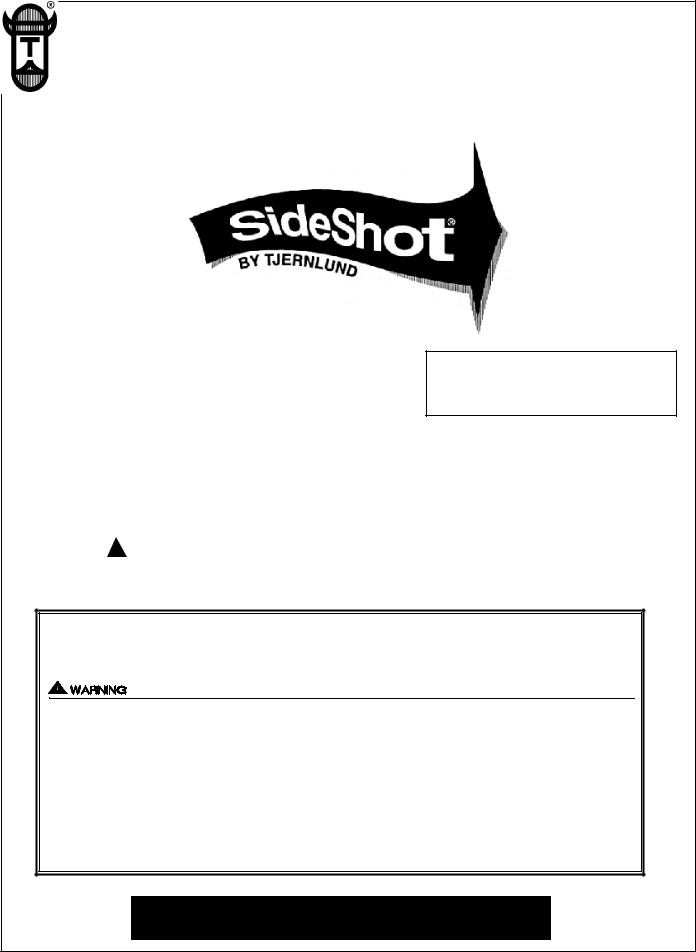
|
|
|
|
|
|
|
|
|
|
|
|
|
|
|
|
REV. C 02/04 |
|
||
|
|
|
|
|
|
|
|
|
|
|
|
|
|
|
|
|
|
||
|
|
|
TJERNLUND PRODUCTS, INC. |
|
|
VERSION |
|
||
|
|
|
PHONE (800) 255-4208 • (651) 426-2993 • FAX (651) 426-9547 |
|
|
|
X.04 |
|
|
|
|
|
1601 Ninth Street • White Bear Lake, MN 55110-6794 |
|
|
|
|
|
|
|
|
|
Visit our web site • www.tjernlund.com |
|
|
|
|
|
|
|
|
|
|
|
|
|
|
|
|
|
|
|
|
|
|
|
|
|
|
|
|
|
|
|
|
|
|
|
|
|
|
|
|
|
|
|
|
|
|
|
|
|
|
|
|
|
|
|
|
INCLUDES NEW UC1
UNIVERSAL CONTROL
MODEL SS1
INSTALLATION INSTRUCTIONS
!Recognize this symbol as an indication of important Safety Information!
OWNER INSTRUCTIONS, DO NOT DESTROY
NOTE: FLUE GAS TEMPERATURES MUST NOT EXCEED 650oF AT VENT SYSTEM INLET.
THESE INSTRUCTIONS ARE INTENDED AS AN AID TO QUALIFIED, LICENSED SERVICE PERSONNEL FOR PROPER INSTALLATION, ADJUSTMENT AND
OPERATION OF THIS UNIT. READ THESE INSTRUCTIONS THOROUGHLY
BEFORE ATTEMPTING INSTALLATION OR OPERATION. FAILURE TO FOLLOW
THESE INSTRUCTIONS MAY RESULT IN IMPROPER INSTALLATION, ADJUST-
MENT, SERVICE OR MAINTENANCE POSSIBLY RESULTING IN FIRE, ELECTRI-
CAL SHOCK, CARBON MONOXIDE POISONING, EXPLOSION, OR PERSONAL INJURY OR PROPERTY DAMAGE.
DO NOT DESTROY. PLEASE READ CAREFULLY AND
KEEP IN A SAFE PLACE FOR FUTURE REFERENCE.
Copyright © 2004, Tjernlund Products, Inc. All rights reserved |
P/N 8504102 |
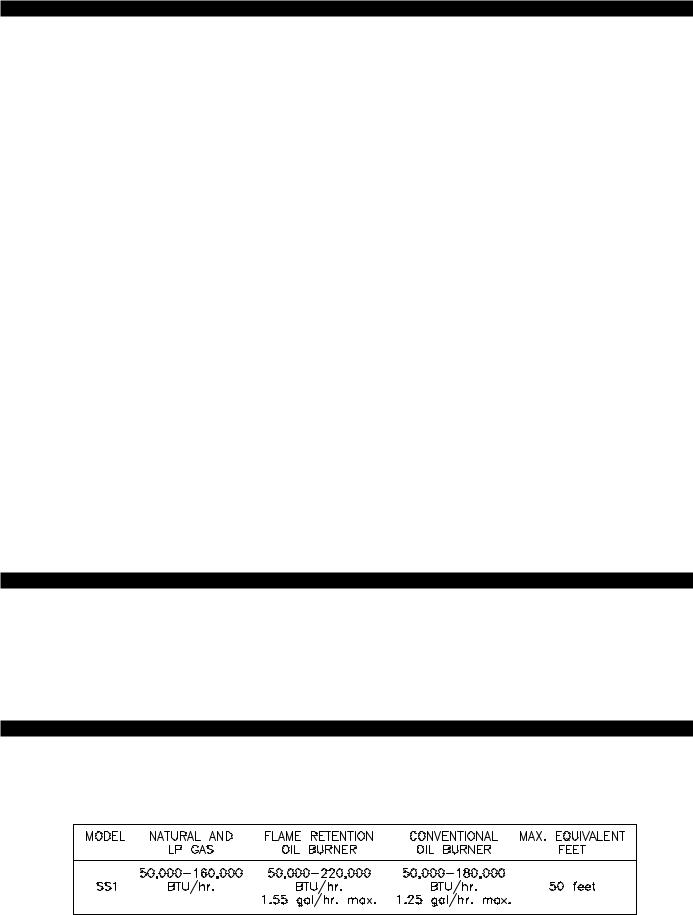
Tjernlund Products welcomes your comments and questions. Address all correspondence to: Customer Service • Tjernlund Products, Inc. • 1601 Ninth Street • White Bear Lake, MN 55110-6794
Call us toll free at 800-255-4208, visit our web site @ www.tjernlund.com or email us at fanmail@tjfans.com.
TABLE OF CONTENTS |
|
|
Page (s) |
Description and Specifications .................................................................................................................................... |
1, 2 |
Installation Restrictions ................................................................................................................................................. |
2 |
Cautions ......................................................................................................................................................................... |
3 |
Safety Inspection of a Previously Used Appliance ......................................................................................................... |
3 |
SideShot Model SS1 Terminology .................................................................................................................................. |
3 |
SideShot® With Integral UC1 Universal Control Board Features ................................................................................... |
4 |
LED Status / Fault Indicators and Fault Retrieval from Memory ................................................................................. |
4, 5 |
Pre / Post-Purge & Pre-Cycle Prover Status Check Settings...................................................................................... |
5, 6 |
Termination Clearances ................................................................................................................................................. |
6 |
Installation |
|
Tools Required ................................................................................................................................................. |
7 |
Vent Hood Installation .................................................................................................................................. |
7, 8 |
Installation of Rain Shield ................................................................................................................................. |
8 |
Plenum Installation ................................................................................................................................. |
8, 9, 10 |
Installation of Vent Pipe ............................................................................................................................ |
10, 11 |
Electrical Wiring |
|
Warnings, Sequence of Operation & Internal Schematic ............................................................................... |
12 |
Wiring to Oil Fired Equipment ...................................................................................................... |
13, 14, 15, 16 |
Wiring to Gas Fired Appliance ................................................................................................................. |
16, 17 |
Draft Adjustment Procedure (Oil) ............................................................................................................................ |
17, 18 |
Draft Adjustment Procedure (Gas) .......................................................................................................................... |
18, 19 |
Combustion Air ............................................................................................................................................................. |
19 |
System Operation Check Out ....................................................................................................................................... |
19 |
Troubleshooting Oil Odors............................................................................................................................................. |
20 |
Troubleshooting Electrical Problems ................................................................................................................. |
20, 21, 22 |
Maintenance ............................................................................................................................................................ |
22, 23 |
Cleaning and Removal & Replacement of Motor/Wheel .......................................................................... |
22, 23 |
Warranty & Replacement Parts ..................................................................................................................................... |
23 |
Mounting Templates |
|
Template B Motor Notch ................................................................................................................................ |
24 |
Template A Vent Hood Terminus.................................................................................................................... |
25 |
SideShot® is a registered trademark of Tjernlund Products, Inc. for their Models SS1 & SS2 Vent Systems.
DESCRIPTION
The SS1 is a mechanical vent system designed and listed for use with natural draft oil or gas heating equipment. It is factory assembled and wired. The SS1 automatically vents the flue gases from heating equipment to the outdoors. By combining outside air with high-tech insulation, surrounding combustible materials and the Vent Hood exterior remain at safe temperatures. After each burner cycle the SS1 will continue to operate in post-purge mode to purge the heater and vent of residual flue gases. A factory post-purge time is set at 2 minutes and is adjustable up 16 minutes, see “Pre / Post-purge Settings” on page 5. The SS1 features a safety system consisting of the integral UC1 Universal Control, a Fan Proving Switch and a High Limit temperature control. These devices monitor the SS1’s performance and will interrupt the main burner if a venting malfunction is detected.
APPLICATION TABLE
Verify that the total BTU/hr. input of the heating appliance(s) fall within the proper category listed below. All BTU/hr. capacity ranges are based on a maximum of 50 equivalent feet. To determine equivalent feet, add the total length of straight vent pipe plus 10 feet for each 90 degree elbow and 5 feet for each 45 degree elbow. Vent runs of over 15 linear feet should use an approved, insulated vent connector to prevent problems related to sulfur condensation.
1
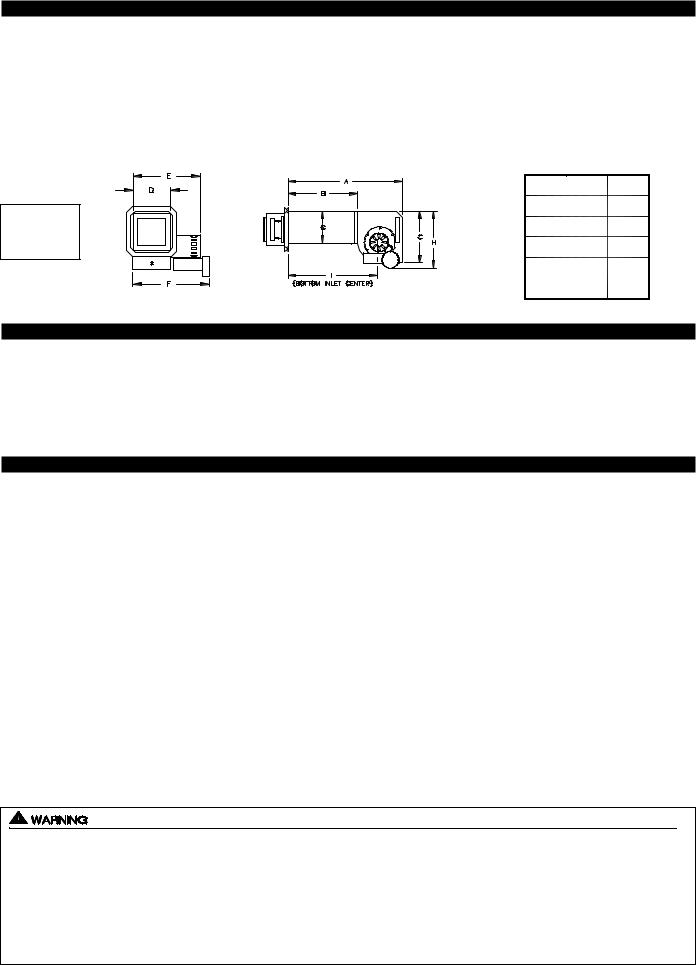
SPECIFICATIONS
Motor: 115/1/60, 3300 RPM, 212 watts, 2.28 FLA
Fan Proving Switch: Non-adjustable set point of -.05" W.C.
High Limit: Manual reset, N/C contacts, open at 135oF + 10oF.
UC1 Universal Control: See UC1 Universal Control Board Features on page 4.
Pre-Purge: Options (0, 5, 20, 35 seconds); Post-Purge: Factory set at 2 minutes, Options (0, 30 seconds or 1, 2, 4, 8, 16 minutes). See page 5 for Pre / Post-purge options.
Rough-In
8” Height
8 3/8” Width
FRONT VIEW |
SIDE VIEW |
|
A |
B |
C |
|
|
|
|
|
|
27 3/8" |
16 1/2" |
12 1/4" |
|
|
|
|
|
|
|
|
D |
E |
F |
|
|
|
|
|
|
8" |
13 3/4" |
15 1/8" |
|
|
|
|
|
|
|
|
G |
H |
I |
|
|
|
|
|
|
7 3/4" |
14 3/4" |
23 1/4" |
|
|
|
|
|
|
|
GENERAL INFORMATION
These units have been factory tested and rated in accordance with AMCA standard 210, Test Code for Air Moving Devices.
Each SideShot is electrically factory line tested before shipment.
After opening carton, inspect thoroughly for hidden damage. Wheel should rotate freely. If any damage is found notify freight carrier and your distributor immediately and file a concealed damage claim.
INSTALLATION RESTRICTIONS
1.The SideShot may not be installed on condensing appliances.
2.For Natural Gas, LP Gas and Oil Fired appliances only.
3.The SideShot may not be installed on an appliance with an automatic valve having a manual opener unless the manual opener has been rendered inoperative or the automatic valve has been replaced with a valve not equipped with a manual opener.
4.The SideShot may only be installed on appliances equipped with a draft hood, draft diverter or barometric draft control.
5.The SideShot shall not be installed where flue gas temperatures exceed 650oF at its inlet. Flue gas temperature verification:
A)On oil fuel, verify flue gas temperature at SS1 inlet is at or above 250oF (121oC) after 5 minutes of operation during setup. See “Oil Draft Adjustment Procedure” on page 18, step 10.
AND
B)Measure temperature of flue gases at the inlet to the SideShot at time of installation. Temperature should be
measured after appliance and SideShot have operated for at least 15 minutes, allowing flue gas temperature to stabilize.
6.Vent runs of over 15 linear feet should use an approved, insulated vent connector to prevent problems related to sulfur condensation.
Improper installation, adjustment, alterations, service or maintenance can cause injury, property damage or death. Refer to this manual. For assistance or additional information consult a qualified installer, service agency or the equipment supplier.
Do not exceed the recommended input range of the SideShot. Under no circumstances shall the minimum draft adjustment be used for the larger input range of this product. Improper adjustment may result in the dispersion of flue products (carbon monoxide) into the building interior causing carbon monoxide poisoning or death.
If oil nozzle is changed or other equipment is added perform “Draft Adjustment Procedure” on page 17 again.
2

CAUTIONS
The SS1 must be installed by a qualified installer (an individual properly licensed and/or trained) in accordance with all local codes or, in their absence, in accordance with the appropriate National Fire Protection Association #31, #54, #211 and the National Electrical Code.
Failure to install, maintain and/or operate the SS1 in accordance with manufacturer's instructions may result in conditions which can produce bodily injury and property damage.
1.The installer must verify that the BTU/hr. input of the appliance does not exceed the recommended input of the SS1. See “Application Table” on page 1 of these instructions for maximum input capacities.
2.Disconnect power supply from the SS1 and heating equipment when making wiring connections and servicing the SS1. Failure to do so may result in personal injury and/or equipment damage. LED #5 (RED) should be off with power removed.
3.Plan the vent layout so that the code required clearances are maintained from plumbing, wiring and combustible materials.
4.The SideShot motor shaft must be mounted horizontally to ensure proper operation of the Fan Proving Switch and prevent motor bearing wear.
5.Flue gas temperatures must not exceed 650oF at SideShot inlet. Ambient temperature must not exceed 104oF.
6.Oil fuel, flue gas temperature at vent system inlet must be at least 250oF during appliance steady state.
7.Make certain power source is adequate for the SideShot requirements. Do not add the SideShot to a circuit when the total electrical load is unknown.
8."Safety Inspection of a Previously Used Appliance", below must be completed when replacing a conventional chimney venting system or when SideShot is installed on used heating equipment.
*SAFETY INSPECTION OF A PREVIOUSLY USED APPLIANCE
(Perform prior to SideShot installation)
The following procedure is intended as a guide to aid in determining that an appliance is properly installed and is in safe condition for continuing use. This procedure is based on central furnace and boiler installations and it should be recognized that generalized procedures cannot anticipate all situations. Accordingly, in some cases deviation from this procedure may be necessary to determine safe operation of the equipment.
a.This procedure should be performed prior to any attempt at modifications of the appliance or installation of the SS1.
b.If it is determined there is a condition which could result in an unsafe operation, the appliance should be shut off and the owner advised of the unsafe condition.
The following steps should be followed in making the safety inspection:
1.Visually inspect the venting system and determine there is no blockage or restriction, leakage, corrosion or other deficiencies which could cause an unsafe condition.
2a. |
Oil Installations: |
Inspect burner and primary control for proper operation. |
2b. |
Gas Installations: |
Conduct a gas leakage test of the appliance piping and control system downstream of the shutoff valve |
|
|
in the supply line to the appliance. |
Inspect burners and cross overs for blockage and corrosion.
3.Applicable only to furnaces: Inspect heat exchanger for cracks, openings or excessive corrosion. Check both the limit control and fan control for proper operation.
4.Applicable only to boilers: Inspect for evidence of water or combustion product leaks. Determine that the water pumps are in operating condition. Test low water cutoffs, automatic feed controls, pressure and temperature limit controls and relief valves in accordance with the manufacturer's recommendations to determine that they are in operating order.
*Excerpts from the National Fuel Gas Code (ANSI Z223.1/NFPA #54), Appendix H.
SIDESHOT® MODEL SS1 TERMINOLOGY
3
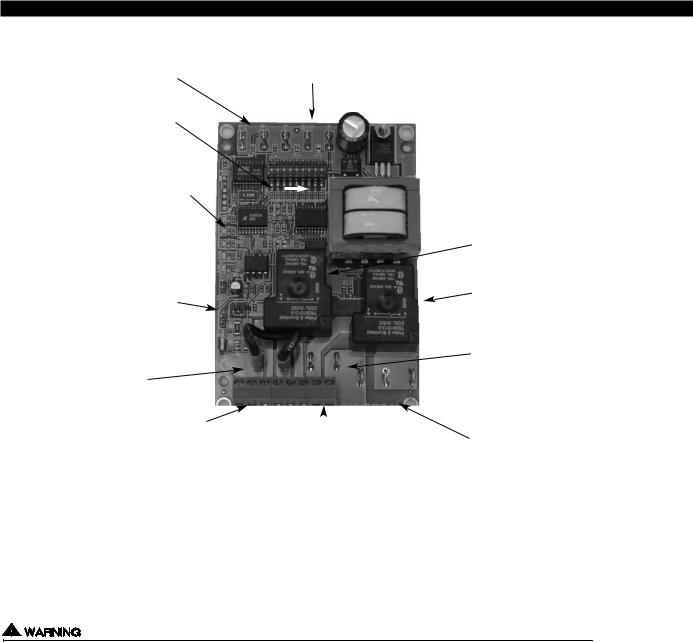
SS1 WITH INTEGRAL UC1 UNIVERSAL CONTROL BOARD FEATURES
|
|
|
P1 - P2 SAFETY CIRCUIT |
|
C, GND, F AUXILIARY DEVICE |
||||||||||
|
|
|
TERMINALS |
|
|
COMMUNICATION TERMINALS |
|||||||||
|
|
|
1 mA @ 5VDC. |
|
|
2 mA @ 5VDC. For Tjernlund MAC1E or |
|||||||||
|
|
|
SEE WARNING # 1. |
|
|
MAC4E auxiliary devices. SEE WARNING # 1. |
|||||||||
|
|
|
|
|
|
|
|
|
|
|
|
|
|
||
|
|
|
|
|
|
|
|
|
|
||||||
|
DIP SWITCH SETTINGS |
|
|
|
|
|
|
|
|||||||
|
Pre-Purge (1-2) |
|
|
|
|
|
|
|
|
||||||
|
Post-Purge (3-8) |
|
|
|
|
|
|
|
|
||||||
|
Prover status check (9) |
|
|
|
|
|
|
|
|
||||||
|
See “Pre / Post Purge & |
|
|
|
|
|
|
|
|
||||||
|
Prover Status Check Dip |
|
|
P1 |
P2 |
C |
GND |
F |
|
||||||
|
Switch Settings”. |
|
|
|
|
|
|
||||||||
|
|
|
|
|
|
|
|
|
|||||||
|
|
|
|
|
|
|
|
|
|
|
|
|
|
|
|
|
|
|
|
|
|
|
|
|
|
|
|
|
|
|
|
|
LED STATUS LIGHTS |
|
|
|
(1 |
9) |
|
|
|||||||
|
See “LED Status & Fault |
|
|
|
|
|
|
|
|
||||||
|
|
|
|
|
|
|
|
|
|
|
|||||
|
Indicator Section” for details. |
|
|
|
LED 1 (AMBER) |
|
|
||||||||
|
|
|
|
|
|
|
|
|
|
|
|||||
|
|
|
|
|
|
|
|
|
|
|
|||||
|
|
|
|
|
|
|
|
|
LED 2 (GREEN) |
|
|
||||
|
APPLIANCE CALL |
|
|
|
|
||||||||||
|
|
LED 3 (GREEN) |
|
|
|||||||||||
|
VOLTAGE SELECTION |
|
|
|
|
||||||||||
|
|
LED 4 (RED) |
|
|
|
||||||||||
|
|
|
|
|
|
|
|
|
|
|
|
||||
|
|
IMPORTANT |
|
|
|
|
|
|
|
|
|||||
|
|
|
|
|
LED 5 (RED) |
|
|
|
|||||||
|
Place RED voltage jumper in |
|
|
|
|
|
|||||||||
|
|
DRY |
|
|
|
|
|
||||||||
|
proper location based on |
|
|
APPLIANCE |
VENTER |
||||||||||
|
appliance call interlock volt- |
|
|
|
|
INTERLOCK |
MOTOR |
||||||||
|
age. SEE WARNING # 2. |
|
24 V |
|
RELAY |
|
RELAY |
||||||||
|
|
|
|
|
|
|
|
|
|
|
|
|
|
||
|
|
|
|
|
|
|
|
|
115 V |
|
|
|
|
|
|
J1J2 CALL |
|
|
|
|
|
||||||||||
JUMPER |
|
|
|
|
|
|
|
|
|||||||
Used when the call signal is |
|
|
|
J1 |
J2 |
XL |
XN |
|
|||||||
used as the “proven” return |
|
|
|
|
|||||||||||
|
|
|
|
|
|
|
|
||||||||
signal to the appliance. See |
|
A B |
1 |
2 3 |
4 L N |
N M MTR |
|||||||||
wiring section for details. |
|
|
|
|
|
|
|
|
|||||||
APPLIANCE INTERLOCK TERMINAL BLOCK (A-B, 1-4)
A - B - Dry Contact call. 3 mA @ 5VDC.
SEE WARNING # 1.
1 - 24 or 115 VAC intercepted call. IMPORTANT: RED voltage jumper must match intercepted call voltage.
2 - 24V common or 115V Neutral.
3 - Common terminal to appliance relay contacts. IMPORTANT: J1-J2 jumper routes call voltage at terminal 1 to 3. Remove J1-J2 jumper if a different voltage source is provided to terminal 3.
4 - Normally open terminal of appliance relay. Will be energized from terminal 3 if safety circuit is “proven”.
L / N - 115  VAC POWER SUPPLY BLOCK
VAC POWER SUPPLY BLOCK
115 VAC / 50-60 Hz
Circuit protection provided by installer.
SEE WARNING # 3.
APPLIANCE INTERLOCK RELAY
1 HP MAX LOAD across terminals 3 & 4.
VENTER MOTOR RELAY
1 HP MAX LOAD from terminals L to MTR & M.
XL / XN AUXILIARY DEVICE POWER TERMINALS
115 VAC - Maximum of 0.15 Amps.
Only connect to Tjernlund auxiliary devices.
SEE WARNING # 1.
MTR & M LOAD TERMINALS FROM VENTER MOTOR RELAY
Used to drive SS1 Motor.
1 HP MAX LOAD across terminals MTR & M / N.
# 1. Power supplied by board. Do not supply power to this area or control damage may result.
# 2. Do not supply power to the appliance interlock block with the call selector in the “DRY” position. Control damage may result if power is supplied.
# 3. Circuit protection must be provided by the installer. 16 Amps is the maximum current allowed for this device at terminal L.VETI
A 15 Amp circuit breaker is recommended.VETI
I A
|
LED STATUS & FAULT INDICATORS |
LED INDICATOR LIGHTS |
|
LED #1 (Amber) |
Appliance call for heat. |
LED #2 (Green) |
Safety circuit through P1 & P2 (SS1 Limit & Fan Prover) is verified “Open” upon start-up. Indicates Venter |
|
prover is closed during run cycle. Burner circuit is energized with contact closure from terminal 3 to 4. |
LED #3 (Green) |
Power switched to SS1 motor from L to MTR & M. |
LED #4 (Red) |
Status / Fault indicator. |
LED #5 (Red) |
115 VAC power supplied to board. Also used as a status indicator. |
LED STATUS INDICATORS |
|
|
LED #4 & #5 (Red) Flashing Alternately |
= Venter in Pre-purge. (Pre-Purge options 0, 5, 20, 35 seconds) |
|
LED #4 & #5 (Red) Flashing in Unison |
= |
Venter in Post-Purge. (Post-Purge options 0, 30 seconds or 1, 2, 4, 8, 16 minutes) |
LED #4 Flashing Continuously* |
= |
Fan Prover opened for more than 10 seconds during burner cycle. |
|
|
(Venter will run for 10 minutes, attempting to make Fan Prover) |
4
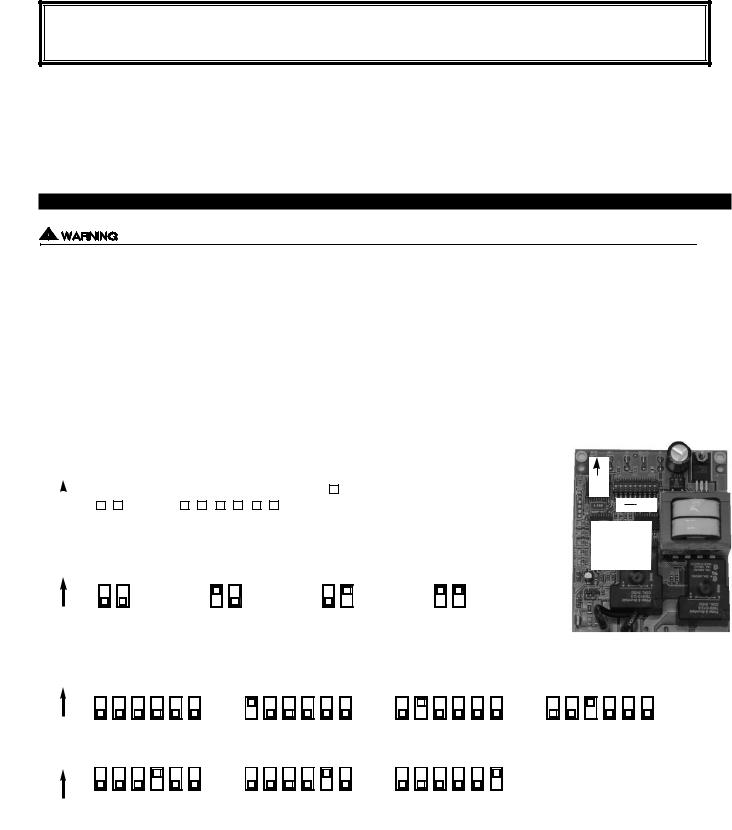
LED FAULT INDICATORS
Fault conditions are indicated by counting the number of times LED #4 (Red) flashes.
LED #4 Flashes 2 |
Times |
Fan Prover was in electrically closed position prior to venter operation. |
LED #4 Flashes 3 |
Times* |
Fan Prover does not close within 60 seconds after call for heat. |
LED #4 Flashes 4 |
Times* |
Fan Prover did not re-close after 10 minutes of Venter operation. |
LED #4 Flashes 5 |
Times* |
Fan Prover opened for more than 10 seconds during burner cycle but closed within 10 minutes. |
*Investigate causes of Fan Prover not making, i.e; Firing burner at capacities or temperatures exceeding Venter limits, excessive vent pipe runs, high winds, plugged / kinked Fan Prover sensing tube or a faulty Fan Prover. Reset SS1 High Limit. If Limit was tripped and SS1 fires, investigate cause of high heat.
IMPORTANT: Fault codes will automatically be displayed after a fault condition occurs. If the call for heat interlock signal or 115 VAC power is removed, the UC1 board will reset and the fault will be stored in memory instead of displayed. Any newtrippedfaultandwillSS1replacefires,anyi vestigatepreviouscausefault. of high heat.
CHECKING MEMORY FOR LAST FAULT CODE
IMPORTANT: Prior to accessing the fault code memory, note the settings of the dip switches so that they can be returned to their original Pre / Post-Purge positions. When power is supplied to the UC1 use caution when moving dip switches.
The last fault code can be retrieved at any time by setting all dip switches 1-8 to the up, or “on” position. The last fault code, or lack there of, will be indicated by counting the number of times LED #4 flashes. By moving any of the dip switches back to their original position, the fault code will be cleared. NOTE: The UC1 board must have its 115 VAC power supply present when any of the (1-8) dip switches are moved back to their original position for the fault code to clear.
PRE / POST PURGE AND PROVER STATUS CHECK DIP SWITCH SETTINGS
Remove power to SS1 and heating equipment when installing, servicing or changing dip switch settings. Failure to do so may result in personal injury and/or equipment damage. LED #5 (RED) should not be on if 115 VAC supply power is removed from the control.
Pre-purge
Used for longer vent runs to get draft fully established throughout the vent system prior to burner ignition. Also beneficial for negative pressure prone environments. IMPORTANT: Nuisance equipment lockouts may occur if our pre-purge is running in conjunction with and is longer than any equipment timing circuit. Pre-purge settings must be shorter than burner control lockout time unless wired prior to burner control timing circuit (i.e. aquastat / thermostat).
Post-purge
A Venter post-purge has been factory set at 2 minutes. Confirm that dip switch #5 is in the up or "on" position. Oil fired equipment requires that the post-purge be long enough to eliminate post cycle nozzle drip odor. A longer post-purge may be necessary for longer vent runs or high heat retention, refractory lined combustion chambers. A shorter post-purge may be desired for gas installations.
|
|
DIP SWITCH NUMBERING |
|
|
|
|
Pre-Cycle |
|||||||||||||
|
|
Pre-Purge |
Post-Purge |
|
|
|
|
Prover Status |
||||||||||||
|
|
|
|
|
|
Check Deactivated |
||||||||||||||
|
|
|
|
|
|
|
|
|
|
|
|
|
|
|
|
|
|
|
|
|
|
|
|
|
|
|
|
|
|
|
|
|
|
|
|
|
|
|
|
|
|
|
|
|
|
|
|
|
|
|
|
|
|
|
|
|
|
|
|
|
|
|
ON |
|
1 |
|
2 |
|
3 |
|
4 |
|
5 |
|
6 |
|
7 |
|
8 |
|
9 |
|
|
PRE-PURGE SETTINGS (SEE “PRE-PURGE” ABOVE PRIOR TO SETTING)
ON |
1 |
2 |
1 |
2 |
1 |
2 |
1 |
2 |
|
0 Seconds |
5 Seconds |
20 Seconds |
35 Seconds |
||||
ON
1  9
9
LED 1 AMBER LED 2 GREEN LED 3 GREEN LED 4 RED LED 5 RED
POST-PURGE SETTINGS (SEE “POST-PURGE” ABOVE PRIOR TO SETTING)
ON |
3 |
4 |
5 |
6 |
7 |
8 |
3 |
4 |
5 |
6 |
7 |
8 |
3 |
4 |
5 |
6 |
7 |
8 |
3 |
4 |
5 |
6 |
7 |
8 |
|
0 Seconds |
|
|
30 Seconds |
|
|
1 Minute |
|
|
|
2 Minutes |
|
|
|
||||||||||
ON |
3 |
4 |
5 |
6 |
7 |
8 |
3 |
4 |
5 |
6 |
7 |
8 |
3 |
4 |
5 |
6 |
7 |
8 |
|
|
|
|
|
|
4 Minutes |
|
|
|
8 Minutes |
|
|
|
16 Minutes |
|
|
|
|
|
|
|
|
||||||||
|
|
|
|
|
|
|
|
|
|
|
|
|
|
|
||||||||||
5
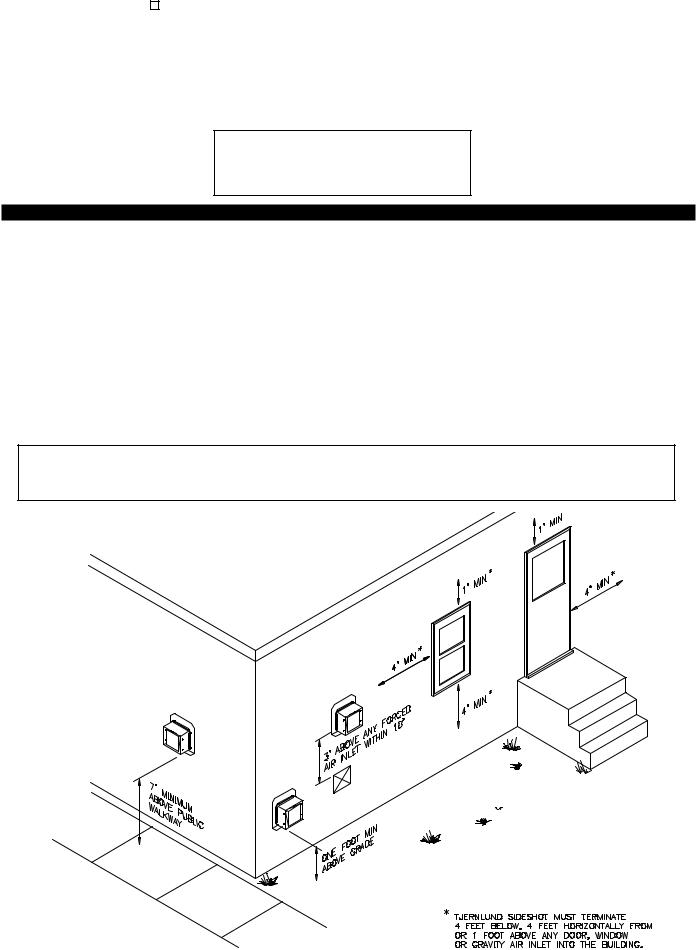
P1 & P2 PRE-CYCLE FAN PROVER STATUS CHECK
Pre-Cycle |
|
The Pre-Cycle Prover Status Check is deactivated from the factory on the SS1 Series. Because of |
Prover Status |
|
the low set point of the SS1 Fan Prover (as low as .03" w.c.) cross winds may cause the Fan |
Check Deactivated |
9 |
Prover to close prior to a call for heat. Activating the Prover Status Check on the SS1 may cause |
|
|
nuisance lockouts. |
|
|
|
|
|
PLENUM AND VENT HOOD CLEARANCE FROM COMBUSTIBLES |
With an inlet flue gas temperature of 650oF or below, the SS1 has been Listed for the following clearances from combustible materials:
IMPORTANT
Vent Hood and top of Plenum: Zero Clearance
Plenum front and sides: 1/2 inch
Plenum rear: 3 inches
VENT HOOD TERMINATION CLEARANCES
The SideShot has been ETL Listed according to the requirements of the National Fire Protection Association #31, #54 and #211 as follows, (See Diagram A).
•The exit terminals of mechanical draft systems shall not be less than 7 feet above grade when located adjacent to public walkways.
•A venting system shall terminate at least 3 feet above any forced air inlet located within 10 feet.
•The venting system shall terminate at least 4 feet below, 4 feet horizontally from or 1 foot above any door, window or gravity air inlet into any building.
•The bottom of the vent terminal shall be located at least 12 inches above grade.
•The exit terminal shall be so arranged that the flue gases are not directed so as to jeopardize people, overheat combustible structures or enter buildings.
•Not to be less than 10 feet from an adjacent building.
The SideShot is also Listed to terminate a minimum of 12” below, above or horizontally from a soffit, deck or adjacent sidewall.
If possible, do not terminate the SS1 on a wall that faces the direction of the prevailing winds. Backdrafts by severe winds can cause oil odors to remain in the structure and/or interrupt heating equipment operation.
DIAGRAM A |
, 4
6
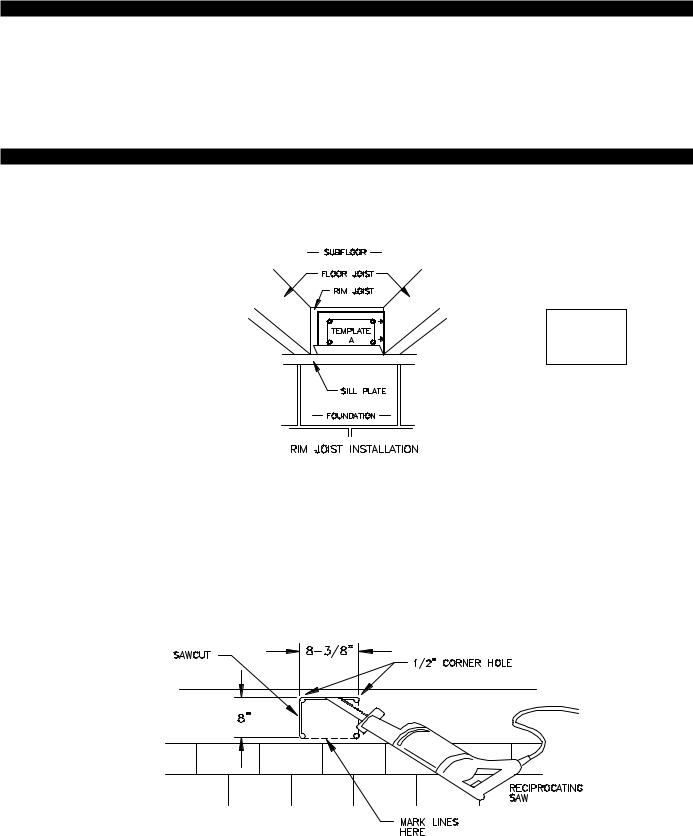
INSTALLATION
Tools required:
• Reciprocating Saw |
• 1/2", 7/16",5/8" Wrench |
• Drill and 1/8", 1/4", 1/2" Bits |
• 1/4" Masonry Drill Bit |
• Blade Screwdriver |
• 1/4", 5/16”, 11/32" Nut Runner or Socket |
• Wire Cutter/Stripper |
• Hammer |
• Tube Cutter |
|
INSTALLING VENT HOOD TERMINUS
1.a) Fold template A (Page 25) along dashed line and attach in between the floor joists ensuring that it is snug against the sill plate and right hand floor joist. Follow same procedure if floor trusses are used, (See Diagram B).
b)If the SideShot is not being installed between floor joists, attach the template to the wall it will be exiting ensuring it is level.
|
Rough-In |
|
DIAGRAM B |
8” Height |
|
8 3/8” Width |
||
|
2.Using 1/2" bit, drill pilot holes noted on each side of the template from inside through rim-joist, wall board, siding, etc., keeping drill bit perpendicular to the wall. 1/2" bit must be long enough to penetrate through exterior.
3.Remove template from rim-joist and attach to building exterior, aligning pilot hole markings on template with holes previously created in Step #2.
4.Drill the four corner holes noted on the template through the building exterior. Remove the template and mark lines from the outside edge of the holes drilled, forming a rectangle.
5.Using reciprocating saw and appropriate blade, cut a rectangular opening through the rim joist, wall board, siding, etc., on the lines marked in step 4. The rectangular opening should be no larger than 8-3/8" in width by 8" in height, (See Diagram C).
DIAGRAM C
6.Knock out block material exposing rectangular opening through the wall.
7.Apply two beads of exterior rated caulk approximately 3/8" in width at the seam of the outermost casing of the Vent Hood and the inner flange of the Vent Hood Terminus, (See Diagram D).
8.Slide the Vent Hood through the wall while taking care installing the rain shield as shown, (See Diagram E). The nuts located on the Vent Hood outermost casing should be facing up when sliding it through the wall. Mount Vent Hood to the exterior using four #8 x 3" wood screws and spacers provided, (See Diagram E). Wall anchors are provided for installation into masonry wall.
7
